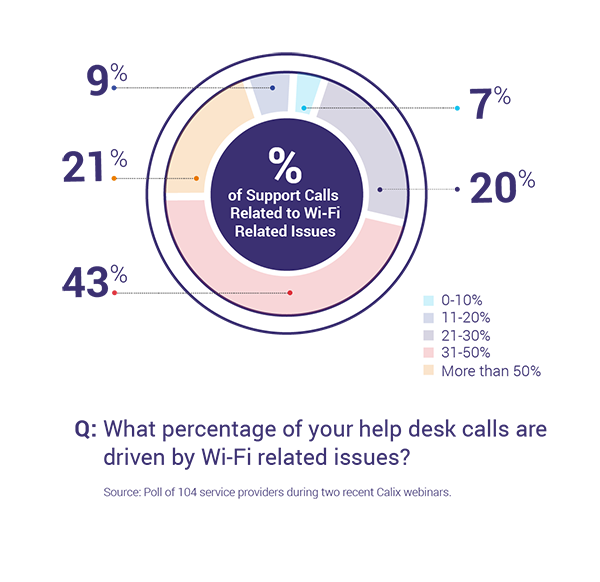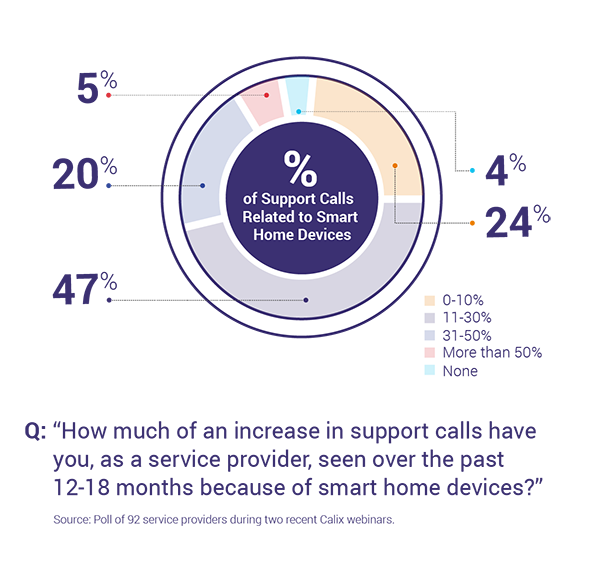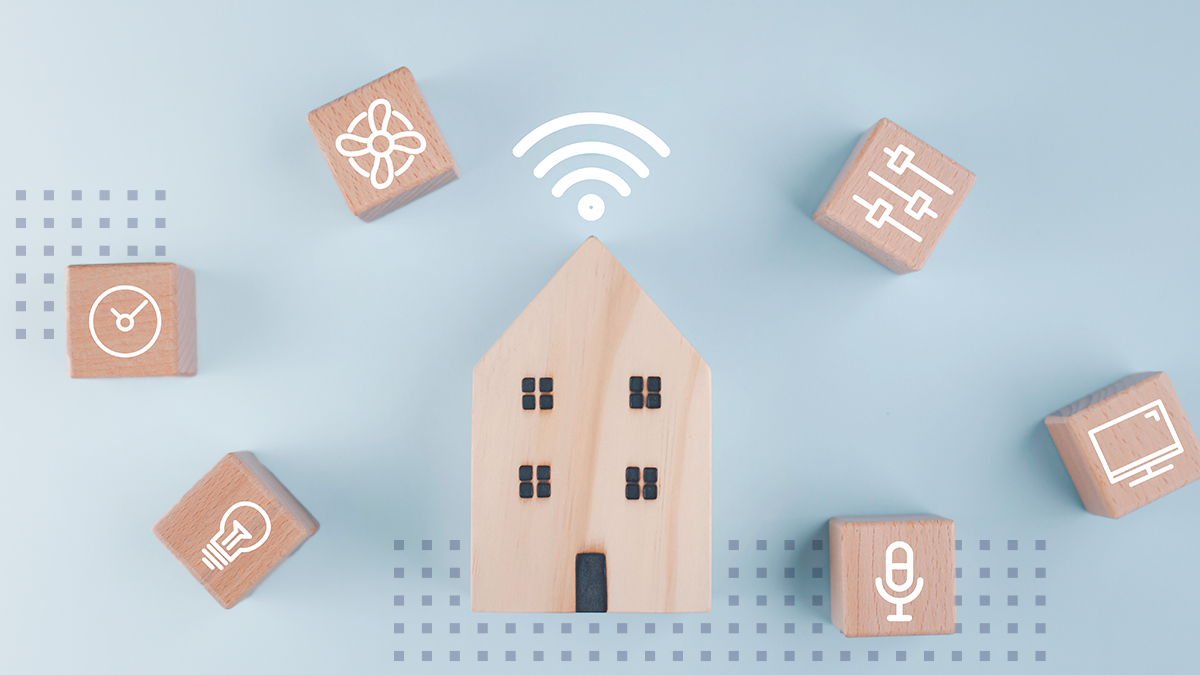Evolution of the Smart Home: Three Steps in the Journey
Thanks to ongoing service provider investments in various access network technologies, many homes across North America have gigabit-speed Internet connections. However, most consumers cannot enjoy a high-speed Internet experience because of limitations with Wi-Fi technology.
One limitation that plagues Wi-Fi is its range, which can be affected by interference from various household devices such as microwaves, garage door openers, and baby monitors. Transmission limitations can also be caused by building materials including metal, concrete, plaster/stucco, and even bricks.
Recent research from Parks Associates indicates that 50 percent of consumers had an issue with Wi-Fi in the last year. To get a sense for how this might impact service providers, Calix conducted polls during two recent webinars. Responses indicate that, for nearly two-thirds (64 percent) of the 104 service providers surveyed, Wi-Fi issues accounted for more than 30 percent of their help desk calls.

To compete effectively, increase revenue from broadband, and expand the footprint in the home, service providers will need to embrace a three-step approach that addresses growing consumer frustration and rising support costs. And it all starts with Managed Wi-Fi.
First Step: What is "Managed Wi-Fi" Anyway?
Typically, a Managed Wi-Fi solution involves providing a carrier-class premises system that can be managed remotely. This means moving away from the ‘BYOD’ model, where subscribers can use any old router they want. This approach, inevitably, is going to cause issues. When consumers struggle with technical issues, as shown in the figure above, many end up calling the service provider help desk looking for assistance—even if the device was purchased at a consumer electronics store or online retailer.
Another challenge with leaving consumers to their own devices to buy their own devices (pun intended), is that companies like Best Buy and Amazon will not only sell them a router. They’ll also sell them in-home Wi-Fi assessments, home network set-up services, and technical support. As Michael Weening, our President and CEO, said in a recent in a previous blog: “Service providers need to prevent that initial networking relationship from being established and assume their rightful place in the smart home.”
For service providers, offering a Managed Wi-Fi service also means deploying software that provides visibility into, and control over, what’s going on in the home network. This allows for advanced troubleshooting support and management of all aspects of the customer’s connected experience. The real-world benefits of this approach are well documented and include:
- enhanced customer satisfaction;
- improved revenue;
- fewer truck rolls;
- reduced average handle times (AHT);
- improved first call resolution (FCR) rates; and
- lower customer support costs.
The bottom line is that service providers need to provide more than just an Internet connection for their subscribers. Not responding to the changing landscape will result, eventually, in service providers being relegated to providing nothing but an Internet connection to the home.
Second Step: Extended Wi-Fi Provides the Ultimate In-home Wi-Fi Performance
The second step for service providers is to help subscribers with their Wi-Fi coverage issues. One approach is to install multiple wireless access points in the home. Under the right circumstances, this approach can address some of the most common issues that consumers have with Wi-Fi, providing connectivity in every part of the subscriber’s home—and beyond. Extended Wi-Fi also provides benefits for consumers with smart home devices like door locks and security cameras, which tend to be installed in outlying areas of the home that might lie beyond the reach of a single wireless access point.
For the service provider, however, there are concerns with consumer-grade ‘Mesh Wi-Fi Network Systems’ purchased from commercial retailers. Namely, if consumers can’t get these systems to work, they are still likely to call the service provider help desk. And, with limited visibility and management capabilities, remotely troubleshooting these devices can be very difficult.
An attractive alternative is for service providers to extend their Managed Wi-Fi offering with a carrier-class Mesh Wi-Fi solution. This allows every additional wireless access point to be managed in the same way as the primary premises system, giving the service provider the ability to view what channel the wireless access points are using, what devices are connected, etc.
This approach has huge benefits for the service provider (including significantly reduced support costs) and for the consumer, as consumer-grade Mesh Wi-Fi systems tend to be sold in groups of three, resulting in costs that can reach as high as $500. Service providers, on the other hand, can purchase carrier-class Mesh Wi-Fi units in volume and install them individually, making the solution more affordable for everyone involved.
Third Step: Rethinking the Home Gateway
According to Parks Associates, 26 percent of U.S. broadband households currently own at least one smart home device. However, these devices are not as easy to set-up and configure as you might expect. In fact, the same research from Parks Associates indicates that nearly half of U.S. broadband households experience an issue when trying to install their new smart home devices.
To quantify the growing impact of smart home devices on service provider support organizations, we polled 92 service providers during two recent Calix-sponsored webinars. Responses indicate that, for one-quarter (25 percent) of the 92 service providers surveyed, issues with smart home devices accounted for more than 30 percent of their help desk calls.

For service providers, the opportunity—as it relates to the smart home of the future—is not about selling more bandwidth to these devices, but about providing an excellent customer experience. Service providers can position their carrier-class premises system as a reliable, intelligent device, providing the central hub for the connected home.
To claim ownership of the connected home of the future, service providers must make the delivery of a positive customer experience a top priority.
The first step is to extend service into subscribers’ homes, with a carrier-class premises system. Next, providing subscribers with additional wireless access points will ensure that coverage and quality meets subscriber demands. These two steps will not only result in an improved subscriber experience, but also lead to reduced operational costs and a more efficient, more competitive service provider. The third and final step is to offer a solution that deals with smart home/IoT devices and places the service provider in the center of the customer experience.
With the rapid growth in sales of smart home devices, consumers are demonstrating a willingness to pay hundreds of dollars for solutions that extend their wireless coverage or provide them with a unique experience. This is an opportunity for service providers to step in with a better alternative and to own the smart home of the future.
Related Articles



